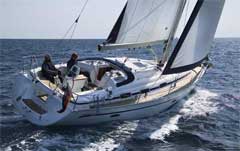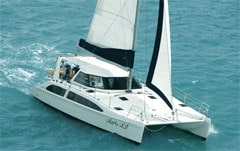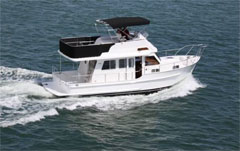Bareboat yacht charter
 Bareboat means ‘You are the skipper, your friends the crew’, but these boats are anything but ‘bare’, usually being very well equipped. Both power boats and sail boats with auxiliary engines are available, ranging in length from about 7 metres (containing 4 berths) up to 15 metres (10 berths). As a rule of thumb, for maximum comfort, the crew should number two fewer than the maximum number of berths on the yacht.
Bareboat means ‘You are the skipper, your friends the crew’, but these boats are anything but ‘bare’, usually being very well equipped. Both power boats and sail boats with auxiliary engines are available, ranging in length from about 7 metres (containing 4 berths) up to 15 metres (10 berths). As a rule of thumb, for maximum comfort, the crew should number two fewer than the maximum number of berths on the yacht.
How to go about a bareboat charter
Bareboat charter bookings are best made directly with the charter company but in some cases may be made through a travel agent. A deposit is required at the time of booking, which is held until the completion of the charter. The balance of the charter fee is usually payable 60 days before the charter begins. Travel insurance is recommended in case it is necessary to cancel.
How much experience is necessary?
Prospective charterers need no formal qualifications. For your own peace of mind someone in the crew should have some experience handling a boat. The crew is given a briefing and checkout aboard the yacht before setting off, at which time the skipper will need to demonstrate that he or she can handle the vessel. The charter company may request that a professional skipper go along for a day or two (at the charterer’s expense) if there is doubt about the competence of the skipper and crew.
How long to charter?
Charters are measured in nights aboard the vessel. They usually begin at midday, and the first afternoon is largely taken up with briefing and being checked out aboard the yacht. The first night will therefore be spent at, or close to, the port of departure (most companies insist that yachts are anchored by 4.00 pm due to the difficulty of seeing fringing reefs when the sun is at a low angle). Charters end on the morning of the final day, so the last night out needs to be spent at an anchorage not too far from home base. So, out of a week’s charter, this leaves five nights of real freedom of choice of anchorages, making a seven-night charter the practical minimum if one is to have enough time to see something of the area without imitating a road-runner.
What type of boats are available?
Charter vessels come in a variety of shapes and sizes. Monohulls (one hull) and Catamarans (two hulls) are available as either sailboats or motorboats. Sailboats are a fun way to experience the peace and tranquility of the area – though not as fast as motor boats, they can’t always cover as much distance in a day. Catamarans offer more space than monohulls, though some people prefer the motion of a monohull in a seaway. Ultimately the choice comes down to personal preference and budget. Most charter companies can provide detailed specifications of their available choices.
A cruising itinerary
The central group of islands are within easy reach of the mainland and island charter bases, and these islands offer many choices of anchorages which have appeal for different reasons; for example, some offer excellent snorkelling, some offer fishing, some have good beaches for swimming, some have resorts. Beware of being too ambitious in drawing up an itinerary. Everyone always wants to see as much of the islands as possible, but just as spending only one night in each city on a world trip can prove exhausting, going to a different anchorage every night may defeat the purpose of a truly relaxing holiday. In practice it’s nice to stay a few nights at some destinations to get into the relaxed rhythm of life aboard, doing only what’s necessary to survive and not thinking about moving on to the next port straight away.
The central islands are the most popular, having the pick of the all-weather anchorages. The southern islands are less frequently visited and may appeal to those seeking greater solitude.
Several of the islands have resorts, some of which welcome visitors in boats provided they register prior to arrival and pay a mooring fee. In most cases this fee gives you the keys to the resort facilities. A stopover at a resort can be a pleasant break in a cruise, making a land-fall and having a night out.
Charter costs
The costs of a bareboat charter include the hire of the yacht, food, marine park fee, and perhaps a few extras, such as mooring fees when visiting an island resort. Charter companies offer a complete provisioning service which takes all the work and worry out of procuring food and planning meals. Several standards of provisioning, from ‘basic’ to ‘gourmet’, are available. Alternatively, charterers can do all the shopping and loading the food aboard themselves, which takes time out of the holiday, or they can provide a shopping list in advance and have the company buy to order (for which a service fee is charged). The cost of a bareboat holiday can become relatively inexpensive if the cost of hiring the boat is divided among a number of crew.
Crewed charters
 For anyone who doesn’t want the responsibility of skippering a yacht on their own, crewed charter vessels operate in the Whitsundays. These vessels come with a licensed skipper and assistant, who run the boat and pamper their guests. Sometimes the guests wish to take over the sailing and decision making, in which case the professional skipper and assistant are usually quite willing to simply become part of the crew. For some charterers this situation offers the best of both worlds being able to skipper the boat themselves while being free of some of the restrictions (and responsibilities) under which bareboat charterers operate, such as the limited charter area (which does not include the Barrier Reef), the need to be anchored by 4.00 pm, and so on.
For anyone who doesn’t want the responsibility of skippering a yacht on their own, crewed charter vessels operate in the Whitsundays. These vessels come with a licensed skipper and assistant, who run the boat and pamper their guests. Sometimes the guests wish to take over the sailing and decision making, in which case the professional skipper and assistant are usually quite willing to simply become part of the crew. For some charterers this situation offers the best of both worlds being able to skipper the boat themselves while being free of some of the restrictions (and responsibilities) under which bareboat charterers operate, such as the limited charter area (which does not include the Barrier Reef), the need to be anchored by 4.00 pm, and so on.
Another variation on the theme is hiring a bareboat and arranging to have a professional skipper as well, in which case the charterer pays the normal costs of the bareboat plus the additional fee for the skipper and his/her food.




